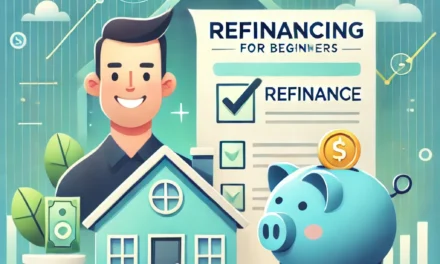Understanding Refinancing for Beginners
Refinancing a home loan can feel like a complex decision, especially for someone new to mortgages, and it is like giving your home loan a makeover! It’s when you take out a new loan to replace your existing one, often to get a better interest rate or different terms. But is it a smart move? But don’t worry—this guide will break down the concept, explain when refinancing makes sense, and show you how it can save you money in the long run with a simple example.
What is Refinancing?
Refinancing means replacing your current mortgage with a new one. The new loan pays off the remaining balance of your old loan, and you start paying the new loan under updated terms. People refinance for several reasons:
- Lower Interest Rate: A lower rate reduces your monthly payments and total interest paid over the life of the loan.
- Change Loan Terms: Extending or shortening the loan term can adjust your payment schedule.
- Access Equity: Some people refinance to borrow against the equity in their home.
When Should You Refinance?
Refinancing works best when:
- Interest Rates Drop: If current rates are lower than when you took your loan.
- You Plan to Stay in Your Home Long Enough: Ensure the savings from lower payments outweigh the costs of refinancing (like closing fees).
- Your Credit Has Improved: Better credit can qualify you for more favorable rates.
Let’s explore the refinancing concepts and break it down with a real-world example (assumes no Closing Costs, PMI and Property Taxes escrows included).
John purchased a home worth $500,000.00 at the beginning of 2023 by paying a down payment of 20% and got a loan for $400,000.00 at a 7.0% interest rate for 30 years.
Initial Loan Details (January 2023)
- House Value: $500,000
- Down Payment: 20% ($100,000)
- Loan amount: $500,000 – $100,000 = $400,000
- Interest Rate: 7%
- Loan Term: 30 years (360 months)
- Monthly payment: (Principal + Interest)
Monthly Payments
| Details | Original Loan |
|---|---|
| Loan Amount | $400,000 |
| Interest Rate | 7% |
| Loan Term | 30 years |
| Monthly Payment | $2,661.21 |
Using a loan amortization schedule, if John continued with the above monthly payments, the total interest paid would be $558,035.59

Now let’s assume that the interest rates have dropped to 6.5%, and John is considering refinancing at the beginning of Jan 2025. Let’s see with the numbers how it would look if John went for another 30 years of loan as part of refinancing.
Amortization Table Summary
Below are snapshots of the amortization schedules for the first 2 years of the original loan:
Original Loan (7%)
| Month | Payment | Interest | Principal | Balance |
|---|---|---|---|---|
| 1 | 2661.21 | 2333.33 | 327.88 | 399,672.12 |
| 2 | 2661.21 | 2331.42 | 329.79 | 399,342.33 |
| 3 | 2661.21 | 2329.50 | 331.71 | 399,010.62 |
| … | … | … | … | … |
| 23 | 2661.21 | 2288.58 | 372.63 | 391,954.60 |
| 24 | 2661.21 | 2286.40 | 374.81 | 391,579.79 |
| Total Paid | 55,448.83 | 8,420.21 |
At the end of 24 months, John would have paid a total interest of $55,448.83 and a total of $8,420.21 towards the principal amount, and the amount of balance remaining for the loan to be repaid would be $391,579.79.
Now let’s see what the numbers would look like when John is going for the refinancing. Would it reduce and save him money during the long run, or will he be paying more in total when we look at all the factors? Let’s explore it in Part II.




